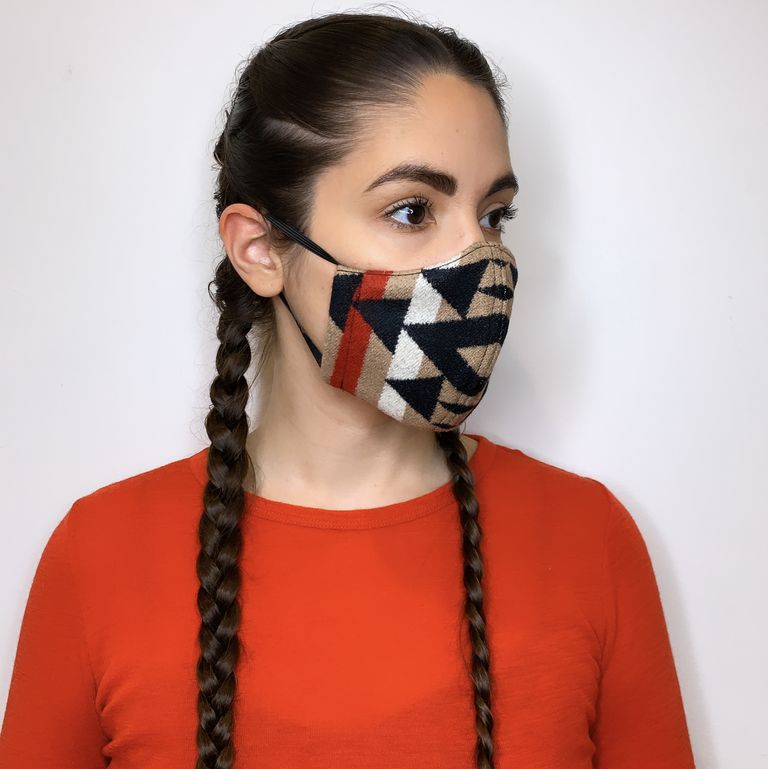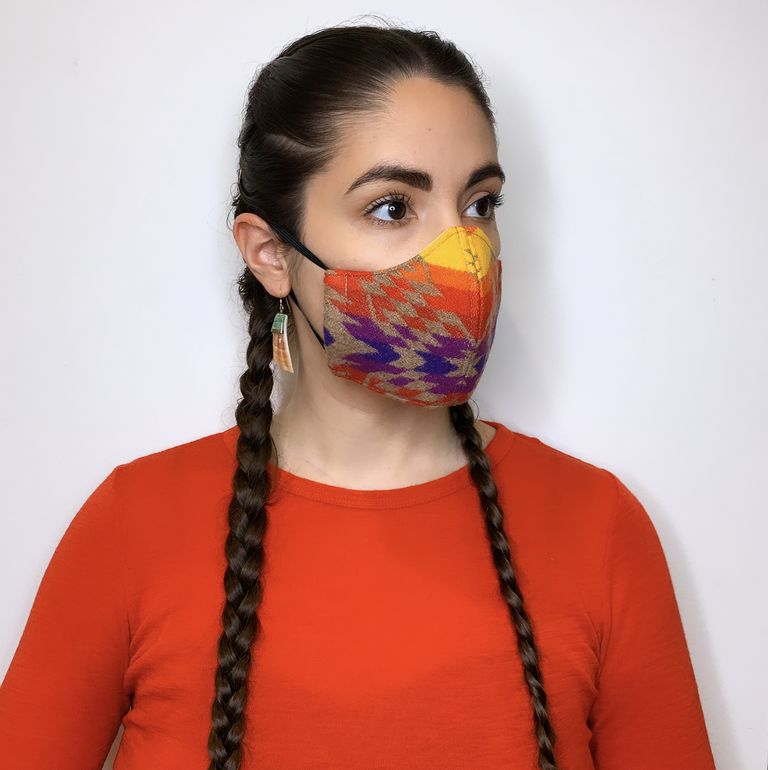Korina Emmerich has been crafting face masks that pay homage to her Indigenous heritage for years, but now that the CDC has urged the general population to cover up in public, it’s hard to keep up with demand.
Holed up with a sewing machine inside her Brooklyn studio, the 34-year-old former Project Runway contestant is crafting hundreds of masks in traditional patterns and rainbow hues. Her colorful designs are simple, and powerful. They represent the sacred relationships between humans and animals, and shed light on the threat of big oil to tribal lands. Emmerich sells the masks on her website, with the caveat that they’re not specifically designed to protect against the coronavirus, because they’re not filtered. (The CDC recommends wearing a multiple layer face covering made of cotton.)
She constantly stocks up on materials and sketches out new designs. Sewing everything herself is time consuming, she tells ELLE.com, but the long hours are a welcome distraction from the loneliness of the pandemic.
“In a time where we all feel out of control, mask making has given me some sort of stability, not just financially, but emotionally,” Emmerich says. “It’s such a difficult time right now trying to find ways to help out in a world where you can’t be physically present, so I’m grateful to have something to wake up and work on every day, because the fear of being stagnant and useless is real.”

Emmerich descends from a long line of Coast Salish Territory fisherman on her father’s side. Her masks are named for fishing terms, like the red, orange, yellow, and green Split Shot design (above), which is a reference to the split shot weight used on a fishing line just above the hook.
She’s made around 200 so far, with plans to sew hundreds more in the coming weeks. They’ll be similarly patterned in bright colors, she says, and their purpose is to draw attention to a variety of indigenous issues, including the anti-pipeline demonstrations that have taken place across North America.
“[Indigenous] masks can carry heavy ceremonial responsibilities in recovery and healing,” Emmerich explains. “Everything created is meant to be used and masks help share traditional teachings in a sort of theatrical way.”

Story telling has a long tradition in Indigenous cultures as a way to teach history, Emmerich says, and masks are “often the center of these teachings, giving life to the stories.” In the Yup´ik tribe of Alaska, for example, driftwood masks are worn during ceremonies to depict relationships among humans, animals, and the spirit world. Pueblo Indians (in northeastern Arizona and northwestern New Mexico) also have ceremonies in which masked men play important roles.
“While the use of masks is different nation to nation,” Emmerich says, “they have always been a part of the Indigenous narrative, literally.”

The materials she sources to make her masks come from Pendleton Mills in Portland, Oregon. They’re 80 percent wool and 18 percent cotton, which “reduces harm to the environment and people, because it’s not produced using chemicals and will biodegrade after disposal,” Emmerich says. “I also think there’s this tongue in cheek ‘fuck you’ to settlers by using wool blanket material as protective wear, considering our history of being impacted by biological warfare in blankets during the small pox epidemic.”
Plus, Emmerich explains, wool is both easy to clean (she recommends sanitizing them in boiling water, or with dish soap and vinegar) and super cozy.
Making masks is just one way she’s pooled resources to support at-risk indigenous populations. Emmerich also balances her site sales with gathering donations for the Indigenous Kinship Collective, an Indigenous group supporting tribal communities and elders during the coronavirus crisis.

Native American communities have been hit particularly hard by the pandemic, with Navajo Nation in the Southwestern U.S. suffering worst of all. As of April 18, the Indigenous community of 173,667 people had 1,197 cases and 44 deaths. According to The Salt Lake Tribune, if Navajo Nation were a state it would would fall at number three for per-capita COVID-19 infections, behind New York and New Jersey.
“Basic preventative measures [like stocking up on groceries] are just not a reality for everyone,” Emmerich says. “The Navajo Nation is in a food desert, with only 13 grocery stores for 180,000 people. Many people also lack basic human resources, like running water.”

